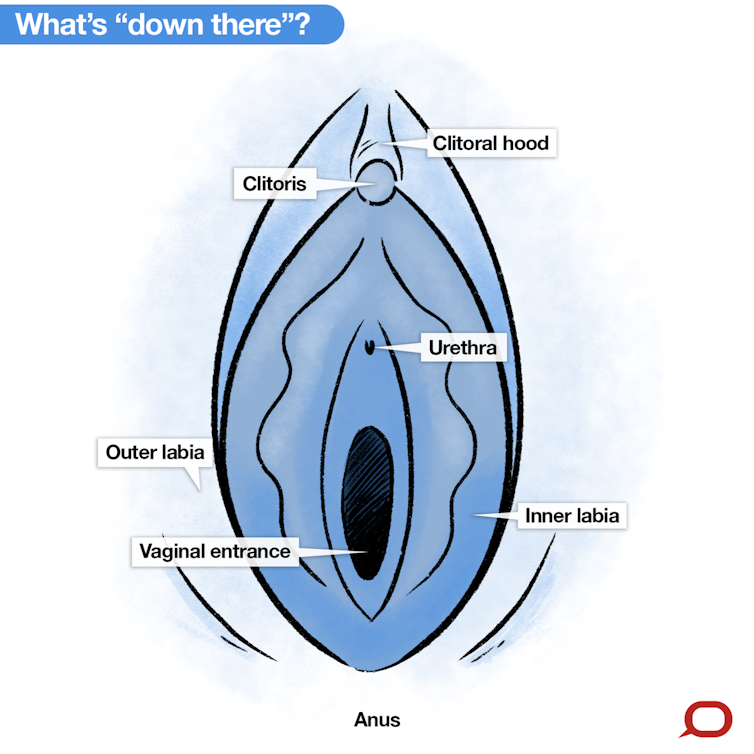Female enjoyment of sex is typically associated with the human species.
But actually all female mammals have a clitoris, the highly sensitive organ that is linked with pleasure and orgasm in women.
And research is now starting to slowly unpack how the clitoris might be involved in sexual encounters in mammals. For example, a research paper presented at a biology conference this week showed that the clitoris in dolphins is very large, and more complex than we previously thought.
Let’s take a look at the biology and evolution of the clitoris – for science.
It starts in the uterus
All babies, regardless of whether they are destined to become a boy or a girl, begin development in the womb with a small bulge called a genital tubercle.
Read more: What makes you a man or a woman? Geneticist Jenny Graves explains
If the developing fetus is destined to become male, the fetal testes will produce the male hormone testosterone and the genital tubercle will develop into a penis. If, on the other hand, the fetus is destined to become a female, the fetal ovary will not produce any hormones and instead the genital tubercle will develop into the clitoris.
Both structures look very similar in the early days of pregnancy.

Since the penis and the clitoris both develop from the same structure, they share many similarities.
The clitoris has a hood in humans: this is the same as the foreskin in males. The clitoris has a glans, which is the same structure as the head of the penis in men. Both the penis and clitoris become engorged with blood when stimulated. And both structures are full of nerves which, at least in humans, provide a pleasurable sensation when stimulated.
A very recent science
But compared to the penis, the clitoris is not well studied even in humans.
Read more: You need more than just testes to make a penis
Amazingly, it was not until the late 1990s that the complete anatomy of the human clitoris was accurately described by Australia’s first female urologist, Helen O’Connell. Her work to understand the detailed form and function of the clitoris provides answers to some basic biological questions about sex.
Such research also has implications in pelvic area surgery, where doctors can use this knowledge to avoid any loss of sexual function.

Read more: 'Is it normal for girls to masturbate?'
Female hyenas are special
Because the penis and clitoris develop from the same tissue in the fetus, anything that affects the hormone balance in the embryo can impact its development. A great example of this is seen in the female spotted hyena.
In this mammal, the female rules the pack. She is larger and more muscular than the males because she is exposed to high levels of male hormones during embryonic development.

But this more muscled physique comes at a cost. The male hormones also affect the clitoris, turning it into a structure that looks like the male penis.
Unfortunately for the female hyena this 20cm clitoris contains the birth canal. So, the female needs to both mate and give birth through her clitoris, which often splits in the process, causing a high death rate in first time mothers.
There are other known differences in clitoris anatomy across species too.
The urethra is the tube through which urine passes to the outside of the body. Many animals have the urethra running through the clitoris (as it does in the penis) while in humans, the urethra opens at the base of the clitoris.

Most mammals also have a small bone in the clitoris to help it become rigid during intercourse. This is known as the os clitoris and again shares a counterpart in the penis, the os penis. Os clitoris and os penis bones are present in most mammals, and humans are unusual in not having one in either organ.
Read more: Lascivious virgins and lustful itches: women's masturbation in early England
Getting lost in the moment
The jury is still out on whether all mammals experience orgasm.
Non-human primates almost certainly do, but it is difficult to measure pleasure in animals.
What is certain is that females who stick around for longer during the act of mating are much more likely to become pregnant and produce more offspring. So if a clitoris does enhance enjoyment, then it would be strongly selected for in nature through increasing the females chance of having offspring.
Although the clitoris is not well studied, there is evidence of larger clitorides – yes, this is the plural of clitoris – in animals in which sex plays an important part in relationship building. Examples include the matriarchal hyena, bonobo chimps, humans and most recently in the dolphin.
Lots of surprises
A paper released this week reveals that female bottlenose dolphins have clitorides similar to humans, and that female dolphins may experience sexual pleasure.
Researchers used a combination of dissections and 3D scans to explore the female genitalia of dolphins in detail.
The shape and structure of the dolphin clitoris is very similar to that of the human. Both animals have extensive areas of erectile tissue that are larger than the clitoral hood. The skin under the clitoral hood also contains bundles of nerves that may increase sensitivity, raising the possibility that sexual experiences can be pleasurable for female dolphins.

However, there are also some differences in the location of the clitoris with respect to the vaginal opening and how it would be stimulated during copulation.
These comparative studies help us learn about the function of genitalia, and the evolution of sexual bonding across species.
Science has revealed a bizarre array of penis shapes found in mammals, from a four-headed penis in the echidna to two-headed penises in many marsupials.
It remains to be seen what surprises the clitoris has in store for us.

